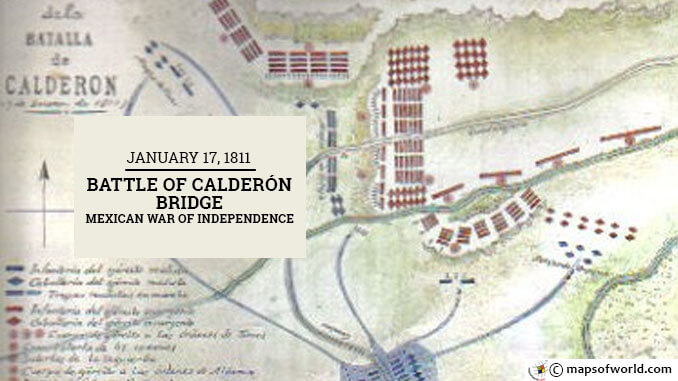The Battle of Calderón Bridge fought on January 17, 1811, was an important battle in the Mexican War of Independence. Over 100,000 Mexican revolutionists led by Ignacio Allende, Juan Aldama, Miguel Hidalgo, and Mariano Abasolo attacked the 6,000 Royalist troops on the banks of the Calderón River near Zapotlanejo, Jalisco. The soldiers fighting for the Spanish crown were led by General Félix María Calleja del Rey. The General was a renowned officer of the Spanish army and went on to become the viceroy of New Spain. Despite overwhelming odds, the troops led by General Calleja del Rey triumphed causing a major setback to the patriots and delaying the cause of the Mexican independence. The General was awarded the title of conde de Calderón for the victory. In 1808, Spain was invaded by Napoleon and his troops. The Spanish King Ferdinand VII was deposed. Spain’s fortunes took a plunge over the next five years with the Napoleonic Wars taking a toll on the exchequer. Despite Ferdinand’s restoration, the Spanish government was strongly divided politically. By 1810, indigenous Mexicans started to voice their demand for independence, having been oppressed by the tyrannical Spanish aristocracy. The independence movement attracted a number of Mexican intellectuals. Initially, however, the Patriots faced a number of setbacks including the Battle of Calderón Bridge. Miguel Hidalgo, the rebel leader was initially the priest of Dolores. In 1810, Hidalgo managed to raise an army and along with Allende made a valiant but futile attempt to take Mexico City. Despite a certain advantage, Hidalgo retreated without storming the city. It is believed that the move was an attempt to spare the inhabitants the pillage that would have been inevitable. The patriots retreated to the nearby provinces and were actively pursued by the Spanish Army led by General Félix María Calleja. In January 1810, the rebel troops, retreated toward Guanajuato. Guanajuato was untenable for the patriots and the royalist forces scored over the insurgents in the interception at Aculco. Hidalgo further retreated towards Guadalajara. Though large in number, the rebels were largely peasants and Indians with little training and used indigenous knives and spears as weapons. The road from Guanajuato to Guadalajara stretched across the River Calderón. The troop of over 100,000 insurgents took position near the Bridge of Calderón, which Allende decided was strategically best-suited for their confrontation. The Royalist General had a much smaller troop in comparison but the soldiers were highly disciplined and were much better equipped. Besides, they were supported by the Spanish cavalry and artillery. The Spanish men were exceptionally brave and Calleja’s officers including officers including Brigadier General José de la Cruz and General Manuel Flon, Count of Cadena, competed to be the first to attack the much larger enemy. Allende planned the defense positions. He asked Mariano Abasolo to command the cavalry unit while the cannons positioned in the hills beyond to offer the Patriots adequate cover. Calleja and his men reached the bridge on January 16 and initiated an attack the next day. The Royalist troops targeted the dump of ammunitions held by the Patriots. As a Spanish cannonball tore into the dump and it exploded, the rebel troops concentrated around it were injured severely. The psychological blow delivered by this incident scattered the insurgents who abandoned action and retreated further north. Calleja pressed his advantage and broke into the enemy lines scattering the rebel army. The Spanish troops killed many insurgents as they tried to flee. Hidalgo, Allende and the other rebel leaders fled towards the Mexico-USA border hoping to successfully make a crossing. Hidalgo and the soldiers accompanying him were captured. Other rebel leaders were also intercepted and sentenced to death. Hidalgo was tried by a civil court and had to face an inquisition. He was stripped of his priesthood and was executed on July 30 that year. Allende and a number of others were executed a few days before Hidalgo. This brought an end to the first phase of the Mexican War of Independence, delaying the cause by almost another decade. Mexico finally gained independence in 1821. In 1932, Calderón Bridge was declared a Mexican historical monument. You may also like : January 17 1706 – American Renaissance Man Benjamin Franklin is Born in Boston
January 17 1811 – Battle of Calderón Bridge – Mexican War of Independence
The Battle of Calderón Bridge fought on January 17, 1811, was an important battle in the Mexican War of Independence. Over 100,000 Mexican revolutionists led by Ignacio Allende, Juan Aldama,…
1.1K
